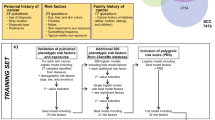Abstract
The role of sun exposure in development of basal cell and squamous cell carcinomas among different populations from south Europe was investigated. Between 1989 and 1993 we interviewed incident cases and a random population sample of controls from five centres where a cancer registry was operating, whereas we selected a sample of hospital-based cases and controls from the other three centres. We gathered information on life-long exposure to sunlight during different activities. Results are analysed for 1549 basal cell carcinoma (BCC) cases and 228 squamous cell carcinoma (SCC) cases compared with 1795 controls. We observed a statistically significant increase of risk of SCC with increasing sun exposure beyond a threshold of 70,000 cumulated hours of exposure in a lifetime. Sun exposures during work and holidays were, however, inversely correlated. Odds ratios (ORs) of SCC were up to eight or nine times the reference for the highest exposures (200,000 cumulated hours or more). BCC exhibited a 2-fold increase of risk for lower exposure (8000-10,000 cumulated hours in a lifetime) with a plateau and a slight decrease of risk for the highest exposures (100,000 cumulated hours or more). Outdoor work showed a significantly increased risk of SCC (OR 1.6 for more than 54,000 cumulated hours of exposure in a lifetime), whereas recreational activities such as sun exposure during holidays at the beach (OR 1.6 for more than 2600 cumulated hours of exposure in a lifetime) or during water sports (OR 1.6 for more than 2600 cumulated hours of exposure in a lifetime) were associated with an increased risk of BCC. Risk patterns were different in poor or good tanners with a significant risk trend for good tanners, whereas poor tanners were on a plateau of increased risk at any level of exposure. Solar radiation is associated with a risk of BCC even for relatively short periods of exposure such as during holidays and sports, whereas SCC develops later if exposure continues. The skin's ability to tan modulates the risk of BCC; subjects who tan poorly have a steady risk increase, whereas people who tan easily develop cancer only after prolonged exposures.
This is a preview of subscription content, access via your institution
Access options
Subscribe to this journal
Receive 24 print issues and online access
$259.00 per year
only $10.79 per issue
Buy this article
- Purchase on Springer Link
- Instant access to full article PDF
Prices may be subject to local taxes which are calculated during checkout
Similar content being viewed by others
Author information
Authors and Affiliations
Rights and permissions
About this article
Cite this article
Rosso, S., Zanetti, R., Martinez, C. et al. The multicentre south European study 'Helios'. II: Different sun exposure patterns in the aetiology of basal cell and squamous cell carcinomas of the skin. Br J Cancer 73, 1447–1454 (1996). https://doi.org/10.1038/bjc.1996.275
Issue Date:
DOI: https://doi.org/10.1038/bjc.1996.275
This article is cited by
-
Occupational solar exposure and basal cell carcinoma. A review of the epidemiologic literature with meta-analysis focusing on particular methodological aspects
European Journal of Epidemiology (2024)
-
Melanoma and CLL co-occurrence and survival: role of KC history
BMC Cancer (2023)
-
Non-melanoma skin cancer among ethnic German immigrants (resettler) from the former Soviet Union: a cohort study from 1990 to 2007
Archives of Public Health (2022)
-
Hydrochlorothiazide use is associated with the risk of cutaneous and lip squamous cell carcinoma: A systematic review and meta-analysis
European Journal of Clinical Pharmacology (2022)
-
Photoprotection in Outdoor Sports: A Review of the Literature and Recommendations to Reduce Risk Among Athletes
Dermatology and Therapy (2022)



